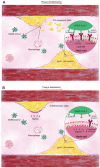Cholesterol in Relation to COVID-19: Should We Care about It?
- PMID: 32570882
- PMCID: PMC7356583
- DOI: 10.3390/jcm9061909
Cholesterol in Relation to COVID-19: Should We Care about It?
Abstract
Current data suggest that infection with severe acute respiratory syndrome coronavirus 2 (SARS-CoV-2) causing corona virus disease-19 (COVID-19) seems to follow a more severe clinical course in patients with cardiovascular disease (CVD), hypertension, and overweight/obesity. It appears that lipid-lowering pharmacological interventions, in particular statins, might reduce the risk of cardiovascular complications caused by COVID-19 and might potentially have an additional antiviral activity. It has been shown that high cholesterol levels are associated with more lipid rafts, subdomains of the plasma membrane that can harbour angiotensin-converting enzyme 2 (ACE2) receptors for the S-protein of SARS-CoV-2. Evidence of the importance of cholesterol for viral entry into host cells could suggest a role for cholesterol-lowering therapies in reducing viral infectivity. In addition to their lipid-lowering and plaque-stabilisation effects, statins possess pleiotropic effects including anti-inflammatory, immunomodulatory, and antithrombotic activities. Lower rates of mortality and intubation have been reported in studies investigating statin therapy in influenza infection, and statin therapy was shown to increase viral clearance from the blood during chronic hepatitis C infection. Statins may also serve as potential SARS-CoV-2 main protease inhibitors, thereby contributing to the control of viral infection. In this review, we elaborate on the role of cholesterol level in the process of the coronavirus infection and provide a critical appraisal on the potential of statins in reducing the severity, duration, and complications of COVID-19.
Keywords: COVID-19; SARS-CoV-2; atherosclerosis; cholesterol; coronavirus; lipid-lowering therapy; statins.
Conflict of interest statement
M.P. has received honoraria and/or travel reimbursement for events sponsored by Amgen, Alfasigma, Mylan, Neopharmed Gentili, Sanofi; M.B.—speakers bureau: Abbott/Mylan, Abbott Vascular, Actavis, Akcea, Amgen, Biofarm, KRKA, MSD, Polpharma, Sanofi-Aventis, Servier and Valeant; consultant to Abbott Vascular, Akcea, Amgen, Daichii Sankyo, Esperion, Freia Pharmaceuticals, Lilly, MSD, Polfarmex, Resverlogix, Sanofi-Aventis; Grants from Sanofi and Valeant. All other authors declare no conflict of interest.
Figures

References
-
- Nabavi S., Habtemariam S., Clementi E., Berindan-Neagoe I., Cismaru C., Rasekhian M., Banach M., Izadi M., Bagheri M., Bagheri M., et al. Lessons learned from SARS-CoV and MERS-CoV: FDA-approved abelson tyrosine-protein kinase 2 inhibitors may help us combat SARS-CoV-2. Arch. Med. Sci. 2020;16:519–521. doi: 10.5114/aoms.2020.94504. - DOI - PMC - PubMed
Publication types
LinkOut - more resources
Full Text Sources
Medical
Miscellaneous

